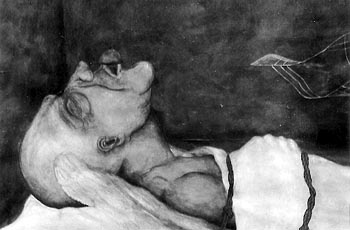Binding Freedom
In the art of the Cartagena brothers at MACLA, there is no painless way to learn the truth
By Ann Elliott Sherman
THE TITLE of their current show at MACLA, Ser ó no Ser/To Be or Not to Be, cuts straight into the existential paradox fueling the art of Carlos and Victor Cartagena--theirs is the freedom that binds. Members of the group of Salvadoran refugee artists known as "Tamo-anchán" (a reference to the Maya's mythological place of origin and concepts of creation out of darkness), the brothers continue to grapple with living in the nowhere zone of an identity founded on unrecoverable losses and unspeakable knowledge.
Fittingly, Carlos' site-specific piece resonates with a question both practical and rhetorical. Closing off the gallery with an "L"-shaped wall topped with jagged broken bottles leaves viewers initially uncertain of their status--inmate or outsider?
A trail of incarnadine fingerprints leads past graffiti reading "Al otro lado del muro son los locos viven" ("Only crazy people live on the other side of the wall"), then turns a corner to a male figure bared of everything save a scraggle of beard. His mouth agape, stained thumb and index finger explaining the source of the trail, the man stands in apparent disbelief over blurred tally marks and the written query "Te acordas?" ("You agree?").
The artist, trapped in asylum, measuring the limits of his confines by the span of his hand, tosses the gauntlet himself: What side of the wall are you on? With its cruel intimidation--no painless way to learn the truth for one's self--we glimpse what it is to be caught on one side of an unnaturally split world.
Carlos' acrylic allegories render the spiritual struggle of living with the burdens of history in immediate, physical terms. Un Nido Para Mis Muertos (A Nest for My Dead) poises a naked figure on a tightrope across the blue blackness of the cosmos. This figure is bent double by the burden of grave markers on his back, a thorny twig in his mouth as counterbalance. As impressive as the uncontrived symbolism is the way Carlos works the color. The shade of blue he uses makes the drawing appear phantasmal, formed from the connected stars of a constellation.
IN HIS SERIES of life-size figure drawings, Victor Cartagena charts the anatomy of a soul equally bound by his silence as constricted by words from the past. Reminiscent of acupuncture charts or anatomical diagrams, these mixed-media pieces are literally made out of the stuff of everyday life: penciled script, coffee, wine. The artist's nude stand-ins are surrounded by swirls of counteracting forces represented by tiny penned arrows of red and blue pointing opposite directions, suggesting the magnetic pull of north and south.
In one untitled work, a man poses like a saint, wearing little golden wings feathered with confettied text. His arms are down at his sides, palms forward, in the classic martyr's submission to divine will. Tatters of airmail letters wrapped across his torso function as sackcloth and thorns. He hovers on tiptoe over a buried skeleton key. His unhappy, staring face is covered in red-inked words, as though tattooed in blood. Like his brother, Victor knows how to milk a metaphor without running it dry.
Pequeños Viajes Nocturnos (Little Night Trips) shows a man with his lips sewn shut and ankles bound by red thread stitched through the paper. In an untitled nightmare, a dead man hangs from a noose. The gap between his feet and the igneous ground (collaged with pages from Neruda's poetry and a single letter) is labeled with the word "Abismo" ("abyss").
Not all the figures are male. In Cabeza de Pájaro, a woman breathing through an oxygen mask stuffed with shredded pages stands over a mass grave of dead birds. Another woman's face is obscured by a hood fashioned of torn letters. Alternating sections of her body are inscribed with a single, repeated word: "luna" (moon). No wonder the artist--now depicted as a partially blurred or blank urban bird (Pájaro Urbano) with individual feathers taped to his body--still wears the staples from open-heart surgery while he plumbs for the center with a bob suspended from the ceiling.
It is the fate of survivors to wonder who they can be if it is the past that makes us who we are. But when survival requires leaving behind all that once defined a life, the answer is likely to be a continual echo. In their resonant soliloquies, Carlos and Victor Cartagena map an undiscovered country that would make cowards of lesser men.
[ San Jose | Metroactive Central | Archives ]
![]()

Acrylic Allegory: A detail from Carlos Cartagena's 'Tus Pañuelos y Mi Aliento' shows the way in which the artist renders in immediate, physical terms the spiritual struggle of living with the burdens of history.
Ser ó no Ser/To Be or Not to Be runs through Oct. 3 at MACLA/San José, 510 S. First St., San Jose. (408/998-ARTE). Artist talk: Thursday (Sept. 17) at 6:30pm.
From the September 17-23, 1998 issue of Metro.
![[Metroactive Arts]](/arts/gifs/art468.gif)